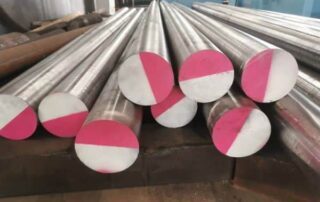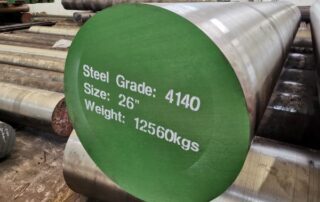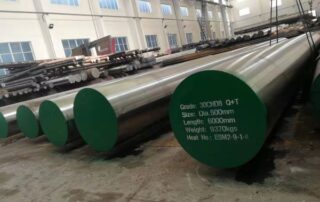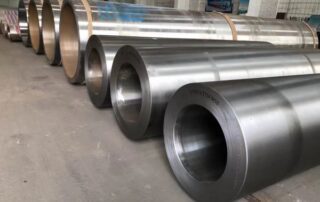WHAT IS ALLOY STEEL?
In addition to iron and carbon, an iron-carbon alloy formed by adding an appropriate amount of one or more alloying elements on the basis of ordinary carbon steel is called alloy steel.
According to the different added elements and appropriate processing technology,alloy steel can obtain corresponding high strength,high toughness,wear resistance,corrosion resistance,low temperature resistance,high temperature resistance,non-magnetic and other special properties.
CLASSIFICATION OF ALLOY STEEL
There are various classification systems for alloy steel. At present, the mainstream classifications mainly include the following:
Classification By Content of Alloying Elements
- Low alloy steel The total content of alloying elements is less than or equal to 5%
- Medium alloy steel The total content of alloy elements is between 5% and 10%
- High alloy steel The total content of alloy elements is greater than or equal to 10%
Classification By Type of Commonly Used Alloying Eelements
- Chrome steel
Typical steel grade:AISI 5140,41Cr4,SCr440
- Manganese steel
Typical steel grade:28Mn6,SMn420,AISI 1330
- Chrome Manganese steel
Typical steel grade:16/20MnCr5,AISI 5120,SMnC420
- Chrome Molybdenum steel
Typical steel grade:AISI 4140,AISI 4130,42CrMo4,SCM440
- Chrome Nickel Molybdenum steel
Typical steel grade:AISI 4340,34CrNiMo6,EN24
Classification By Function & Purpose
- Structural steel
Structural alloy steels are steels that meet specific strength and formability grades. Formability is expressed as elongation after break in tensile test. Structural steel is generally used for load bearing and other applications where the strength of the steel is an important design criterion.
Generally divided into structural steel for construction and engineering which is used as engineering components (pipes and brackets, etc.) and structural steel for machinery manufacturing, used as various mechanical parts (shafts, gears, springs, impellers, etc.)
- Tool steel
Alloy tool steel is the steel used to manufacture cutting tools, measuring tools, molds and wear-resistant tools.
Tool steel has high hardness, maintains high hardness and red hardness at high temperature, as well as high wear resistance and appropriate toughness.
- Special Performance steel
Special performance steel has special physical or chemical properties. In addition to certain mechanical properties, it also requires special properties.
There are many types of special performance steels. In machinery manufacturing, stainless steel, heat-resistant steel and wear-resistant steel are mainly used.
THE FUNCTION OF ALLOYING ELEMENTS IN STEEL
- Introduction for alloying elements
The main alloying elements of alloy steel are silicon, manganese, chromium, nickel, molybdenum, tungsten, vanadium, titanium, niobium, zirconium, cobalt, aluminum, copper, boron, rare earth, etc.
Vanadium, titanium, niobium, and zirconium are strong carbide-forming elements in steel. As long as there is enough carbon, their respective carbides can be formed under appropriate conditions.When carbon is deficient or under high temperature conditions, they enter into solid solution in atomic state.
Manganese, chromium, tungsten, and molybdenum are carbide-forming elements, some of which enter the solid solution in atomic state, and the other form replacement alloy cementite.
Aluminum, copper, nickel, cobalt, and silicon are elements that do not form carbides and generally exist in solid solutions in an atomic state.
- The specific function of common alloying elements
Silicon(Si)
Silicon is used as one of the main deoxidizers in the steelmaking process.Once the silicon content in steel exceeds 0.50-0.60%, silicon is considered an alloying element.
Silicon can significantly improve the elastic limit, yield point and tensile strength of steel, so it is widely used as spring steel.If 1.0-1.2% silicon is added to the quenched and tempered structural steel, the material strength can be increased by 15-20%.
Silicon can be combined with molybdenum, tungsten, and chromium alloying elements, which can improve corrosion resistance and oxidation resistance,so it is used to manufacture heat-resistant steel.
Low carbon steel containing 1-4% silicon, with extremely high magnetic permeability, used for silicon lamination in electrical industry.
However, increasing the amount of silicon will reduce the weldability of the steel.
Manganese (Mn)
In the process of steelmaking, manganese is a good deoxidizer and desulfurizer.Generally, the content of manganese in steel is 0.30-0.50%.Once adding more than 0.70% Mn to carbon steel, it is considered “manganese steel”.
Manganese not only gives the steel higher strength, better hardness, and more resistance to wear,but also improves the hardenability and the hot working performance.
Steel containing 11-14% manganese has extremely high wear resistance which is used for excavator buckets, ball mill lining plates, etc.
However, the increase of manganese content weakens the corrosion resistance of steel and reduces the welding performance.
Chromium (Cr)
In structural steels and tool steels, chromium can significantly improve strength, hardness, hardenability and wear resistance, but at the same time reduce ductility and toughness.
Chromium can also improve the oxidation resistance and corrosion resistance of steel, so it is the most important alloying element of stainless steel and heat-resistant steel.
Nickel (Ni)
Nickel can improve the strength of steel while maintaining good plasticity and toughness. Nickel has high corrosion resistance to acid and alkali, rust and heat resistance at high temperature.
When a proper amount of nickel is introduced into high chromium (stainless steel) steel, it will become austenitic stainless steel which is tougher,maintains good ductility,and has strong corrosion resistance.
However, since nickel is a relatively scarce resource, other alloying elements should be used instead of nickel-chromium steel.
Molybdenum (Mo)
Molybdenum can refine the grains of steel, improve hardenability and thermal strength, and maintain sufficient strength and creep resistance at high temperatures (long-term stress at high temperature, deformation occurs, called creep).
Molybdenum is added to structural steel to improve strength,hardness,hardenability,and toughness. Molybdenum can inhibit the temper brittleness of alloy steel due to quenching.
In hot-work steels and high speed steels, Molybdenum increases red-hardness properties.
Titanium (Ti)
Titanium is a strong deoxidizer in steel. Titanium can make the internal structure of steel compact, refine grains, and reduce aging sensitivity and cold brittleness.
Adding appropriate titanium to austenitic stainless steel can be used as a stabilizing element which fixes carbon in inert particles, improving corrosion resistance and weldability.
Since Titanium is a rare element on Earth, this alloying element can be up to 200 times more expensive than regular carbon steel.
Vanadium (V)
Vanadium is an excellent deoxidizer for steel. Adding 0.5% vanadium to the steel can refine the grain structure which can improve the strength,toughness,wear resistance and resistance to shock impact.
Carbides formed by vanadium and carbon can improve the resistance to hydrogen corrosion under high temperature and high pressure.
Vanadium is most commonly used in high-speed metal cutting tools because of its enhanced red hardness property.
Tungsten (W)
As a precious alloying element, tungsten has a high melting point and a large specific gravity.Tungsten carbide formed from tungsten and carbon has high hardness and wear resistance.
Adding tungsten to high-speed steel and hot working tool steel can significantly improve the red hardness and thermal strength,and have superior hot-working and greater cutting efficiency at elevated temperatures.
Copper (Cu)
Copper can improve strength and toughness, especially atmospheric corrosion performance (copper content between 0.2%-0.4%).
However, copper has a negative effect on forging and welding and is prone to hot embrittlement during hot working.
The plasticity decreases significantly when the copper content exceeds 0.5%. When the copper content is less than 0.50%, it has no effect on the weldability.
Aluminum (Al)
Aluminum is the most effective and commonly used deoxidizer in steel.Adding a small amount of aluminum to the steel can refine the grains and improve the impact toughness.
Aluminum also has anti-oxidation and anti-corrosion properties. When used in combination with chromium and silicon, it can significantly improve the high-temperature corrosion resistance of steel.
Aluminum is often added to nitrided steels because it forms hard aluminum nitride with nitrogen.Such as EN41B, 41CrAlMo7 steel.
However, aluminum affects the hot workability, weldability and machinability of the steel.
Cobalt (Co)
Cobalt is a rare precious metal that is mostly used in high-speed steels,hot forming tool steels,and high temperature materials.
Cobalt improves red hardness,high temperature strength,and permits higher quenching temperatures.
However,Cobalt does not form any carbides.
THE PRINCIPLE OF CHOOSING ALLOY STEEL
The selection of alloy steel, like other types of materials, is a relatively complex issue, and it is an extremely important part of the design of various mechanical products.
In order to produce high-quality products, comprehensive consideration must be given to the structural design of the product, alloy material selection, hot and cold processes, and production costs.
Correct and reasonable selection of alloy materials is the basis for ensuring the best performance, working life, safety and economy of products. The general principles for the selection of alloy materials are now introduced as follows:
- Meet the performance requirements of the products
The performance of the material refers to the performance that the material must have to ensure the normal operation of the product. It includes mechanical properties, physical properties and chemical properties.
Various mechanical products, due to their different uses, working conditions and other factors, also have different requirements for their components, which can be expressed as the following three types of differences.
- Stress condition:Load properties (static load, dynamic load, alternating load),Stress form (tension, compression, bending, torsion, shear), Distribution (concentrated distribution, uniform distribution) and Strength, Stress condition.
- Working environment: Temperature (normal temperature, high temperature, low temperature or variable temperature), Medium (corrosive medium, lubricant).
- Other requirements:such as thermal conductivity, density and magnetic properties.
The performance of the material is determined on the basis of a comprehensive analysis of the working conditions.For example, fatigue performance is required under alternating load, good toughness is required for work under impact load, and corrosion resistance is required for working in corrosive media such as acid and alkali.
- Meet the process performance of the products
Process performance refers to the performance of the material to adapt to processing during the manufacturing process, that is,casting performance, forging performance, welding performance, machining performance and heat treatment process performance.
The quality of the material process performance has a direct impact on the processing and production of the product. Good process performance can not only ensure the manufacturing quality of products, but also help improve productivity and reduce costs.
Therefore, process performance is also a problem that must be considered in material selection.When we are going to choose alloy steel, the specific issues that need to be considered are as follows:
Question One:Does the alloy steel have good casting performance?
Question Two:Does the alloy steel have good pressure processing performance?
Question Three:Does the alloy steel require to have certain weldability?
Question Four:Does the alloy steel need to have good machinability?
Question Five:Does the alloy steel have good heat treatment process performance?
- Meet the economic principle of the products
The principle of economy not only refers to the selection of the cheapest materials or products with the lowest production cost, but also refers to the use of value analysis methods to comprehensively consider the impact of materials on the function and cost of products to achieve the best technical and economic benefits.
For the design and selection of materials, the premise of ensuring economy is accurate calculation, rather than blindly selecting higher-level materials or simply replacing the inferior with the superior.
In addition, suitable materials should be selected according to the stress, temperature, corrosion resistance and other conditions of the product, rather than simply pursuing a certain index.
TYPICAL APPLICATION FOR ALLOY STEEL
| No. | Application series | Representative steel type | Description |
1 | Petroleum machinery series | AISI4130,AISI4140,AISI4150 | Valve body, valve block, |
| 30CrMo,4145H | Drill pipe, drill collar | ||
2 | Tool mold series | 1.2714,5CrMnMo,5CrNiMoV, | Die casting mold, forging mold, |
| 1.2738,1.2311,1.2312 | Plastic mold | ||
3 | Bearing series | 52100,GCr15,SUJ2 | Bearing ring, rolling bearing, |
| Piston rod | |||
4 | Marine series | 4140,42CrMo,SCM440, | Marine accessories |
| 709M40 | |||
5 | Car series | SAE8620,20CrNiMo,SAE8622 | Crankshaft, gear |
| SNCM220 | |||
6 | Heavy-duty transmission series | 40CrNiMo,SNCM439, | Port transmission parts, |
| SAE4340,EN24 | Helicopter rotor shaft, turbine shaft | ||
7 | Mining machinery series | 655M13,826M40, | Mining bit, carburizing and |
| 25CrMo | Crushing machinery | ||
| 8 | Wind power gear series | 18CrNiMo7-6, 17CrNiMo6, 1.6582,1.6587,SAE8620 | Meet the design life of more than 20 years |
| 9 | Wind power spindle series | 34CrNiMo6,817M40 | Meet the design life of more than 20 years |
10 | Nitriding series | 20MnCr5,38CrMoAl,EN41B | Gear, injection molding machine |
| 31CrMoV9 | Screw,barrel,precision components | ||
11 | Pressure vessel series | 15CrMo,13CrMo4-4 | Boiler, petrochemical hydrogenation |
| Vessel accessories | |||
12 | Metallurgical roll series | 21CrMoV5-11,W1.7225,16CrMo44V | Steel rolling roller |
| EN19,709M40 |














